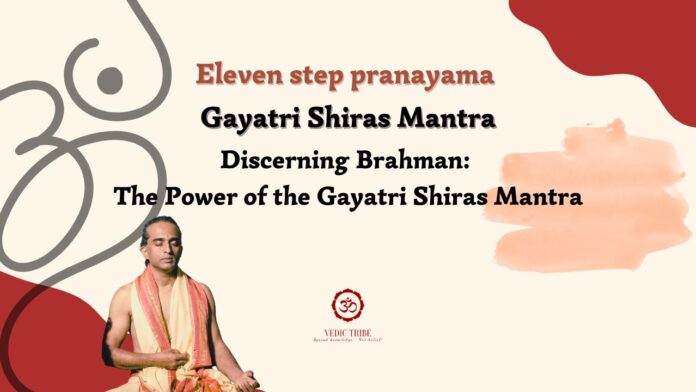In the previous article titled “Eleven-step Pranayama – Gayatri Mantra”, we discussed the eighth step i.e., the path of Brahman. From the eighth step, the breath is retained and after the Gayatri Mantra, Gayatri Shiras Mantra is recited in mind as the nineth step.
In this article, we will discuss the ninth step or the ninth level – i.e., Gayatri shiras mantra
ओमापो ज्योती रसोऽमृतं ब्रह्म भूर्भुवस्सुव॒रोम्
(Om apo jyoti raso amrutam brahma bhurbuvassuvarom)
Discerning Brahman: The Power of the Gayatri Shiras Mantra
In Vedic tradition, Brahman is the ultimate reality or the absolute truth. It is the source of all existence and the cosmic consciousness that permeates everything. This mantra provides four esoteric names of Brahman:
Ap – Ever Fluid: The term “Ap” in Vedic tradition is often associated with water. In the Rig Veda, it’s mentioned as one of the primordial elements from which the universe emerged. It symbolizes the fluid, boundless, and all-pervasive nature of reality.
Jyoti – Eternally Luminous: The term “jyoti” in Vedic tradition is associated with luminosity. Brahman is seen as the ultimate source of consciousness and knowledge. Just as light illuminates the physical world, Brahman illuminates the spiritual realm. It dispels the darkness of ignorance and leads us towards enlightenment.
Rasa – Ultimate Essence: In the Vedic context, “rasa” can be understood as the essence, flavour, or the underlying principle of a thing. It’s the subtle, intangible quality that gives a thing its unique identity. Brahman, being the transcendental essence or the divine flavour of reality – is called the ultimate essence. It is the ultimate experience of bliss and pure consciousness that is the goal of spiritual seekers.
Amruta – Eternal Elixir: In Vedic tradition, Brahman is referred to as Amruta due to its immortalizing quality. Amruta is the divine nectar of immortality. By realizing Brahman, one transcends the cycle of birth and death, attaining eternal life.
The deities:
In Vedic tradition, the deities for this mantra are the Parabrahman along with Agni, Vayu and Aditya.
Sri Aurobindo describes Parabrahman as “the Absolute Unmanifested,” “the Transcendent and incommunicable,” and “the Supracosmic Existence that sustains the cosmos.” It is beyond all qualities and attributes, and it cannot be known by the human mind.
However, Parabrahman is not entirely unknowable. Sri Aurobindo suggests that it can be experienced through a process of spiritual realization, in which the individual consciousness transcends its limitations and unites with the absolute. This experience is beyond the realm of intellect and can only be described in symbolic terms.
By consciously uttering the Gayatri Shiras Mantra, we invoke Parabrahman along with Agni, Vayu & Aditya and elevate our consciousness to observe the qualities of Parabrahman, experiencing its fluidity, luminosity, essence and eternity. This transformative experience will lead to the ultimate goal of spiritual practice: the realization of one’s true nature as pure consciousness.
After this step, the retention of breath ends with closing “om”. As you can observe, this last “om” is built-in the mantra itself (at the end suvah+om). Nonetheless, we will discuss the last “om” in the next article.
In the next article, the tenth step “the tenth Pranava” will be discussed.
Madhwesh K
Vedic Tribe

